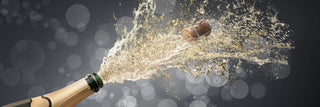The Champagne region
Champagne is the most famous sparkling wine region in the world, surrounded by picturesque hills and vineyards. It is located in the northeast of France, 200 km from Paris. The main Champagne towns are Reims, Epernay and Ay, many of the most prestigious champagne houses, such as Krug , Veuve-Clicquot , Roederer , Pommery , Mumm , Piper-Heidsieck , Taittinger , and Moët & Chandon , among more than 300 wineries or Maison de Champagne, are located in these towns.
The grapes allowed in the Champagne Denomination of Origin are seven, but mainly Pinot Noir , Chardonnay and Pinot Meunier account for most of the production, the remaining Pinot Blanc, Pinot Gris, Arbanne and Petit Meslier are varieties with which champagne was formerly made and that currently they are more in disuse, although there is some processor that is recovering them, it is only 3%.
The soil in the area is largely chalk, giving the wines a distinct minerality. The climate is cold and harsh, and the vintages are inconsistent, which gave rise to the practice of blending or coupage.
The Monk Dom Perignon
It was in the middle of the 17th century when the peasants of the Champagne region, in order to compete with the wines of Burgundy , began to differentiate themselves by making white wine from black grapes. They called it the "grey wine", which they named it that way because of its whiteness and brilliance, which imitates glass, and which would have great success at the Court of the King of France.
Epernay is well known for being close to the Abbey of Saint-Pierre, where the legendary Benedictine monk, Dom Pérignon , responsible for the vineyards, presses and cellars belonging to the Abbey from 1668 to 1715, supposedly invented the Method of making a wine sparkling, although some believe that Limoux (rather than Champagne) is the region where second fermentation in the bottle was first practiced.
Limoux is much cooler than nearby regions due to the extremely high elevation of the vineyards and the influence of the Atlantic. The ability of this climate to produce refreshing wines with brilliant acidity has led its residents to specialize in sparkling wine .
Some of the Maison de Champagne and their cellars are admirable
A royal recognition
It is in Reims, in the heart of the Champagne region, that the kings of France were crowned. The ceremonies were accompanied by parties in which the champagne flowed freely. Very quickly appreciated for its flavor and delicacy, champagne became the wine offered in homage to the monarchs who came to the region.
It was in the 18th century that champagne began to gain worldwide renown, thanks to famous globetrotters such as Claude Moet , Philippe Clicquot , Florenz-Louis Heidsieck and in the 19th century, Pierre-Nicolas-Marie Perriet-Jouet , Mumm , or Bollinger finished finish off the work of its predecessors by giving French Champagne this glamorous and elegant image that distinguishes it so much throughout the world. Famous widows such as Mrs. Pommery , Mrs. Clicquot and Mrs. Perrier had to take over their husbands' businesses and completed the promotion of a champagne of irreproachable quality.
Perhaps it is because of this relationship between champagne and the coronations of French royalty that this drink has always been linked to celebrations and festivities.
Nuances about French champagne
Champagne is not a wine like the others. What sets it apart is really its palette of flavors—even champagnes made from pinot noir or pinot meunier offer nuances you don't get in any still white wine. The real difference is of course the bubbles which play a big part in table chords.
If we are going to serve champagne at night, it is important not to tire the palate with champagnes that are too vinous, what counts at this moment is the freshness and delicacy of the bubbles.
French champagne as an aperitif
Champagne is traditionally served at this time. The ideal is to start the festivities with a blanc de blancs Champagne made only with Chardonnay grapes, because it will bring us freshness, minerality and a touch of tropical fruits that make it ideal for an aperitif.
Champagne in the first course
If our starter dish is made up of marine products such as oysters, scallops, clams, clams, razor clams or other molluscs, we can continue with the same champagne as the aperitif or move on to a young brut champagne . In the case of crustaceans such as lobster, prawns, prawns, lobster, langoustines, spider crabs, crabs, etc, or fish with some type of sauce, we will accompany them with a slightly more vinous and older champagne.
French champagne with the main course
To accompany roasted poultry (turkey, chicken), we will have some pinot noir grape champagne , or pinot meunier at its base. If our dishes are more elaborate with stuffed meats, fish with strong sauces, the ideal champagne is the grand cuvées, which have often been aged ten years in the cellar.
French champagne with cheeses and desserts
Most champagnes go well with a lot of cheeses, as long as they are not too strong. For a long time, champagne was just a dessert wine and although currently the different types of champagne are ideal to accompany all kinds of dishes, in desserts it is still king, although we must not skip some rules.
- Pink champagne is perfect for our red berry desserts, and for classic cakes, sweet or semi-sweet champagne would be ideal.
- Champagne is not really suitable for chocolate, especially if you like it dark, bitter, with a high percentage of cocoa.
Dom Pérignon , Mumm , Ruinart , Taittinger , Bollinger , Piper-Heidsieck , Gosset , Lanson.



